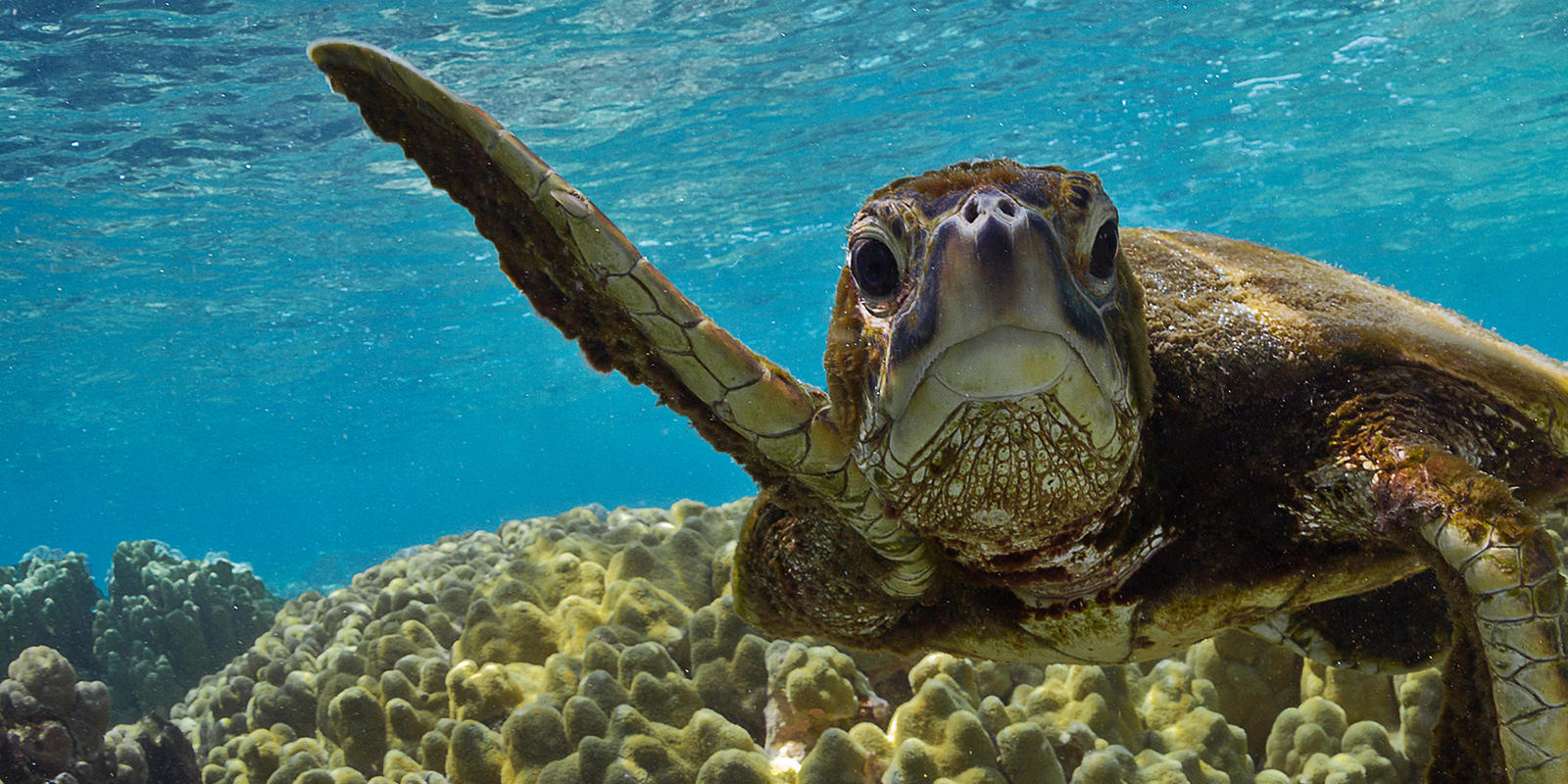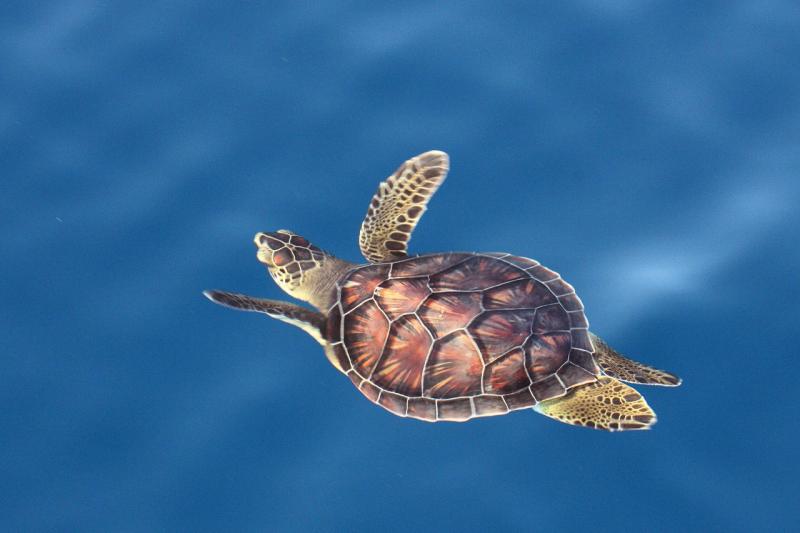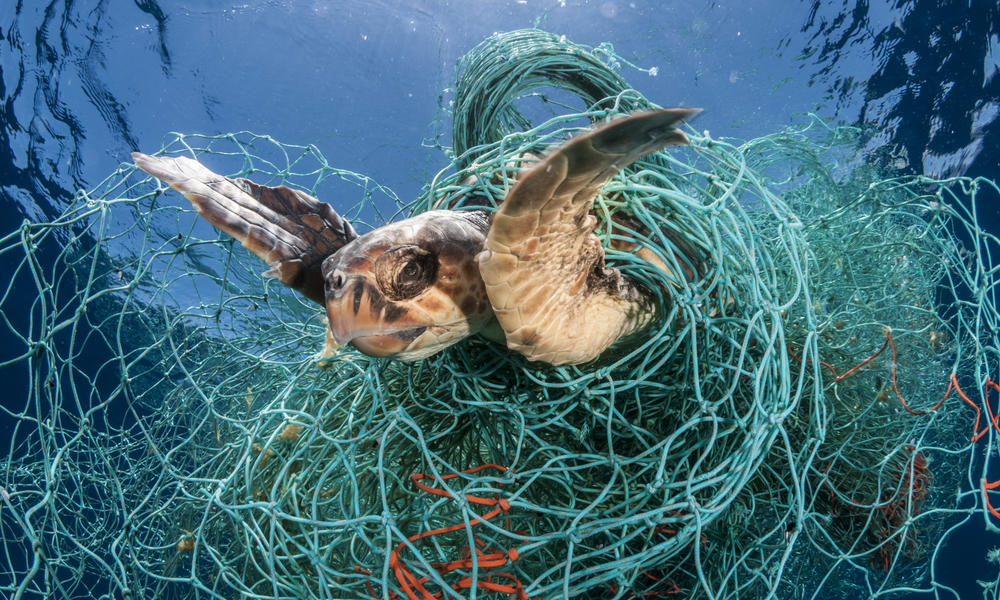Sea Turtles | Marine Biology
Often considered the most majestic of the turtle family, the sea turtle is a large, ocean-going reptile known for its gentle nature and long lifespan. Although numerous animals, from invertebrates to mammals, have evolved shells, none has an architecture like that of turtles.
Sea turtles are reptiles remarkably suited to life in the sea. Their hydrodynamic shape, large size, and powerful front flippers allow them to dive to great depths and swim long distances. These front flippers are long, narrow, and winglike, while their hind flippers are shorter. Although sea turtles can remain submerged for hours at a time while resting or sleeping, they typically surface several times each hour to breathe.
Seven different species of sea turtles grace our ocean waters, from the shallow seagrass beds of the Indian Ocean, to the colorful reefs of the Coral Triangle and the sandy beaches of the Eastern Pacific. While these highly migratory species periodically come ashore to either bask or nest, sea turtles spend the bulk of their lives in the ocean.Turtles are very adaptive and can be found on every continent, except Antarctica. Most turtle species are found in south-eastern North America and South Asia. Only five species live in Europe.
Turtles are not social creatures. While they typically don’t mind if there are other turtles around them, they don’t interact or socialize. Turtles are not silent creatures. Some sound like electric motors, some sound like belching humans and some bark like dogs.
Most turtles are omnivores; they eat a variety of different things, depending on their species. Musk turtles eat molluscs, plants, small fish and insects.Male and female sea turtles do not differ externally until they approach maturity. Adult males have longer, thicker tails than females, because the male reproductive organ is housed in the base of the tail. In males, the tail may extend beyond the hind flippers. With the exception of the leatherback turtle, the claws on the fore flippers of sea turtle males are elongated and curved, which may help them grasp a female's shell during mating.
All turtles lay eggs. They find a place on land to lay their eggs, dig a nest into the sand or dirt and then walk away. No species of turtle nurtures their young. Turtles reach the age to mate at different times. Some come of age as young as a few years old, while others don’t reach sexual maturity until around 50 years has passed.Some species fight for the right to mate with a female, while others seduce her with a mating ritual. To mate, male and female turtles intertwine their tails so that their shell openings line up perfectly. Sea turtles travel from the ocean to lay eggs on beaches. Usually, sea turtles lay around 110 eggs in a nest, though the flatback turtle only lays 50 at a time.
However, over the last 200 years, human activities have tipped the scales against the survival of these ancient mariners. Slaughtered for their eggs, meat, skin, and shells, sea turtles suffer from poaching and over-exploitation. Climate change has an impact on turtle nesting sites; it alters sand temperatures, which then affects the sex of hatchlings. They also face habitat destruction and accidental capture—known as bycatch—in fishing gear.Sea turtles virtually everywhere are affected by fisheries, especially longlines, gill nets, and trawls. Plastics, discarded fishing gear, petroleum by-products, and other debris harm and kill sea turtles through ingestion and entanglement. Light pollution disrupts nesting behaviour and causes hatchling death by leading them away from the sea.
If you enjoyed reading this, you might like my previous post on Dolphins, check it out:
https://musings-of-a-musical-biologist.blogspot.com/2021/06/sea-horses-marine-biology.html
Citations:
About sea turtles-
https://ocean.si.edu/ocean-life/reptiles/sea-turtles
https://www.britannica.com/animal/turtle-reptile
https://www.nwf.org/Educational-Resources/Wildlife-Guide/Reptiles/Sea-Turtles
Where sea turtles are found-
https://www.worldwildlife.org/species/sea-turtle
Sexual Dimorphism-
https://seaworld.org/animals/all-about/sea-turtles/characteristics/
Offspring-
https://www.livescience.com/52361-turtle-facts.html
why are sea turtles endangered-?
https://www.worldwildlife.org/species/sea-turtle
http://www.bonaireturtles.org/wp/explore/why-are-sea-turtles-endangered/








A good read, Chloe!
ReplyDeleteGood writing ��. Hope to read more on marine life.
ReplyDelete